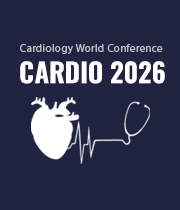Title : Impact of raised neutrophil/lymphocyte ratio and neutrophil x platelet/lymphocyte ratio on outcomes following isolated urgent coronary artery bypass graft surgery
Abstract:
Objectives: Neutrophil to Lymphocyte Ratio (NLR) has been suggested as a strong predictor of cardiovascular disease risk. However, the evidence remains limited for the effect on post-operative outcomes in patients undergoing Coronary Artery Bypass Graft (CABG) surgery. This study analyses the effect of NLR and Neutrophil x platelets/lymphocytes ratio (NPLR) on the outcomes of post-operative patients following isolated urgent CABG. NPLR is a relatively novel marker introduced to examine the effect on post-operative outcomes in patients undergoing urgent CABG surgery. The study will also identify the correlation between NLR versus NPLR and post-operative outcomes. The primary outcomes are in-hospital mortality and total length of hospital stay. The secondary outcomes include new post-operative atrial fibrillation, renal and neurological complications, wound infection, and re-admission to intensive care unit (ICU).
Methods: We conducted a retrospective analysis for patients undergoing isolated urgent CABG. All patients undergoing isolated urgent CABG surgery from the year 2020-2025 were identified from our online database. Records were then matched to identify the pre-operative blood results, including neutrophils, platelets, and lymphocytes. This yielded a total of 612 patients. Univariate and multivariate analysis were performed using Logistic regression analysis to identify predictors for outcomes. Optimal Cut-off value for NLR and NPLR identified using receiver operating characteristic (ROC) curve. High and low NLR and NPLR groups were compared. Independent t-test used for continuous variables and Chi-squared test for categorical values. A p-value ≤0.05 was considered statistically significant for all comparisons.
Results: NLR≥ 3 was associated with longer duration of ventilation (4.9 vs 2.9 hours; p=0.002) and longer hospital stay (16.67 vs 15.81 days; p=0.036). NPLR correlated better with outcomes, showing significant difference for in-hospital mortality (5.6% vs 1.7%; p=0.007), duration of ventilation (6.1 vs 3.1 hours; (p<0.001), total hospital stay (17.7 vs 15.71 days; p=0.036), wound infection rate (4% vs 1%; p=0.010) and renal complications (5.6% vs 4.3%; p=0.003) for NPLR≥ 1167 vs NPLR<1167.
Conclusion: Advanced age, gender(male), pre-operative atrial fibrillation, use of intravenous nitrates, reduced left ventricular function, logistic EuroSCORE, Neutrophil/lymphocyte ratio, and Neutrophil x platelets/lymphocytes ratio were strong predictors of in-hospital mortality. Neutrophil x platelets/lymphocytes ratio correlates better with outcomes. These findings suggest that Neutrophil/lymphocyte ratio and Neutrophil x platelets/lymphocytes ratio are valuable tools in predicting post-operative outcomes for isolated urgent coronary artery bypass graft surgery.




